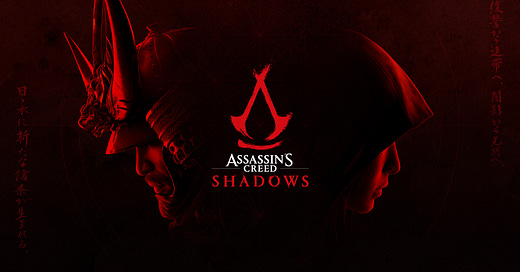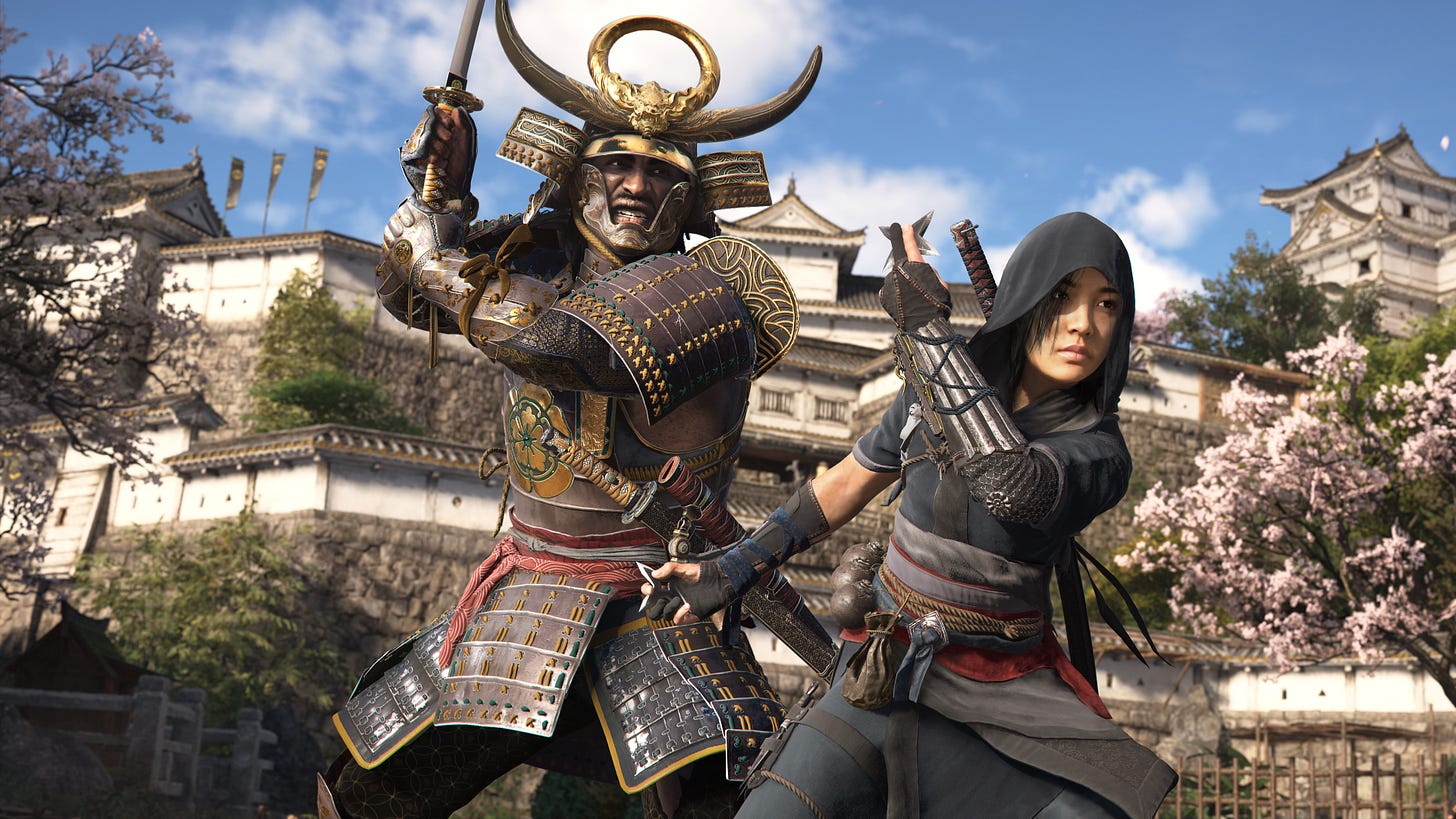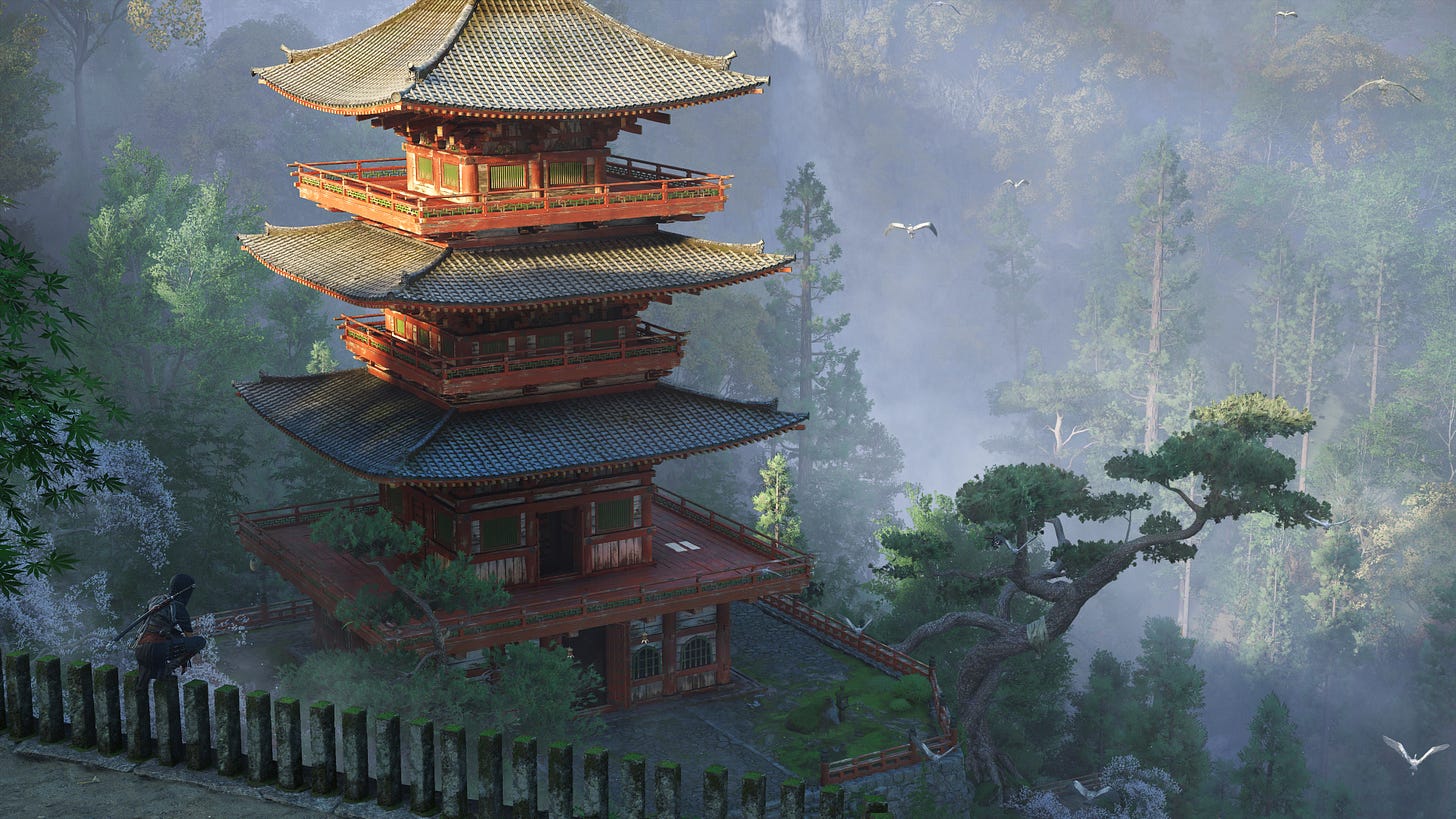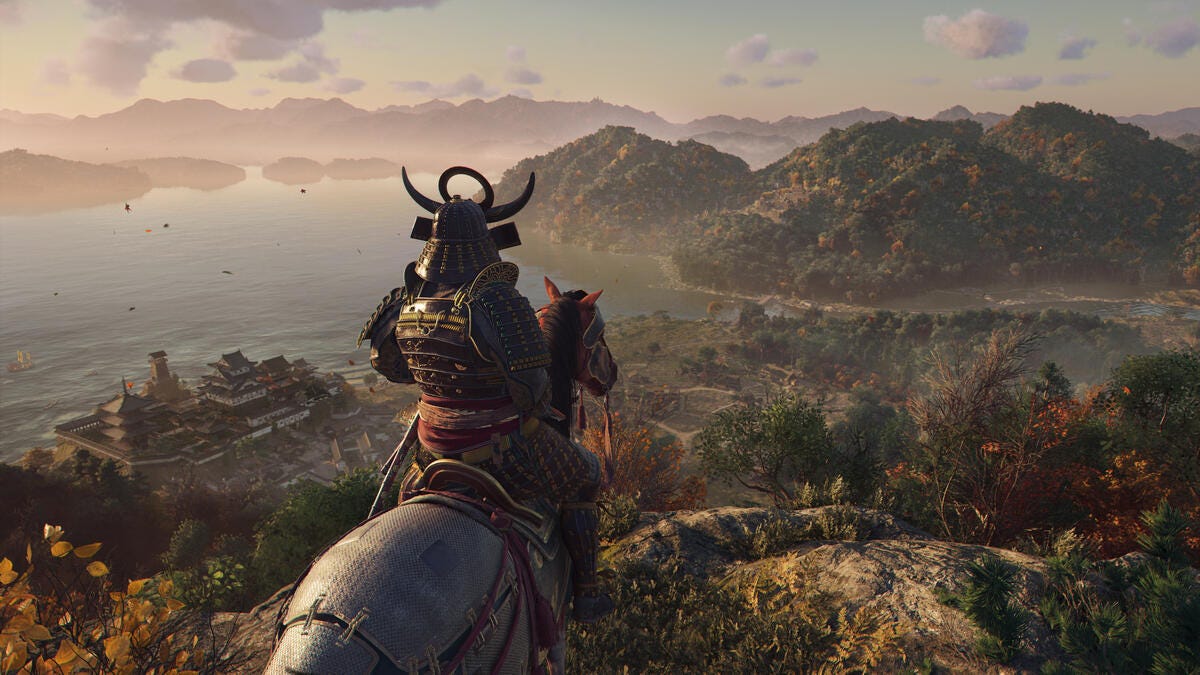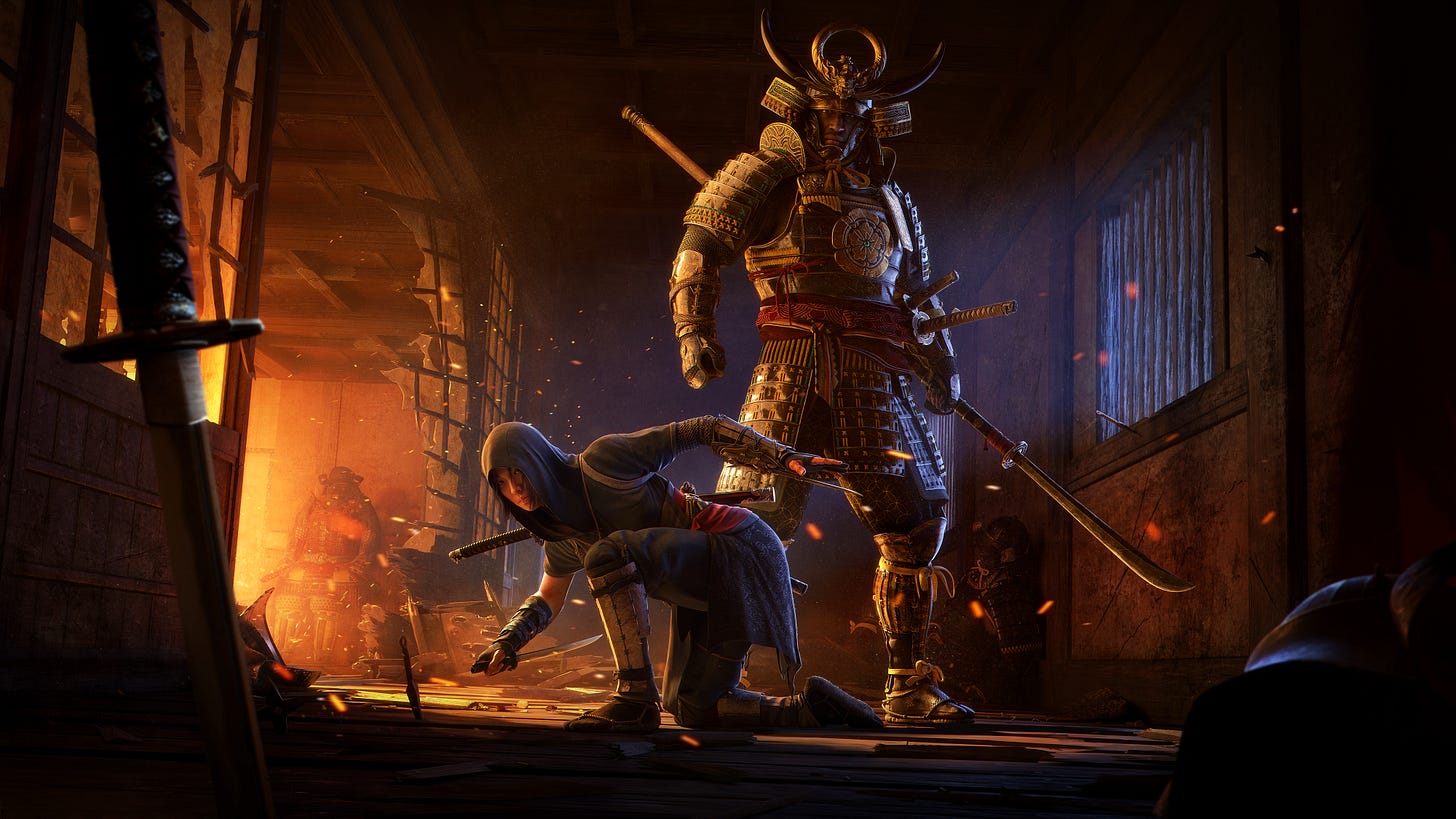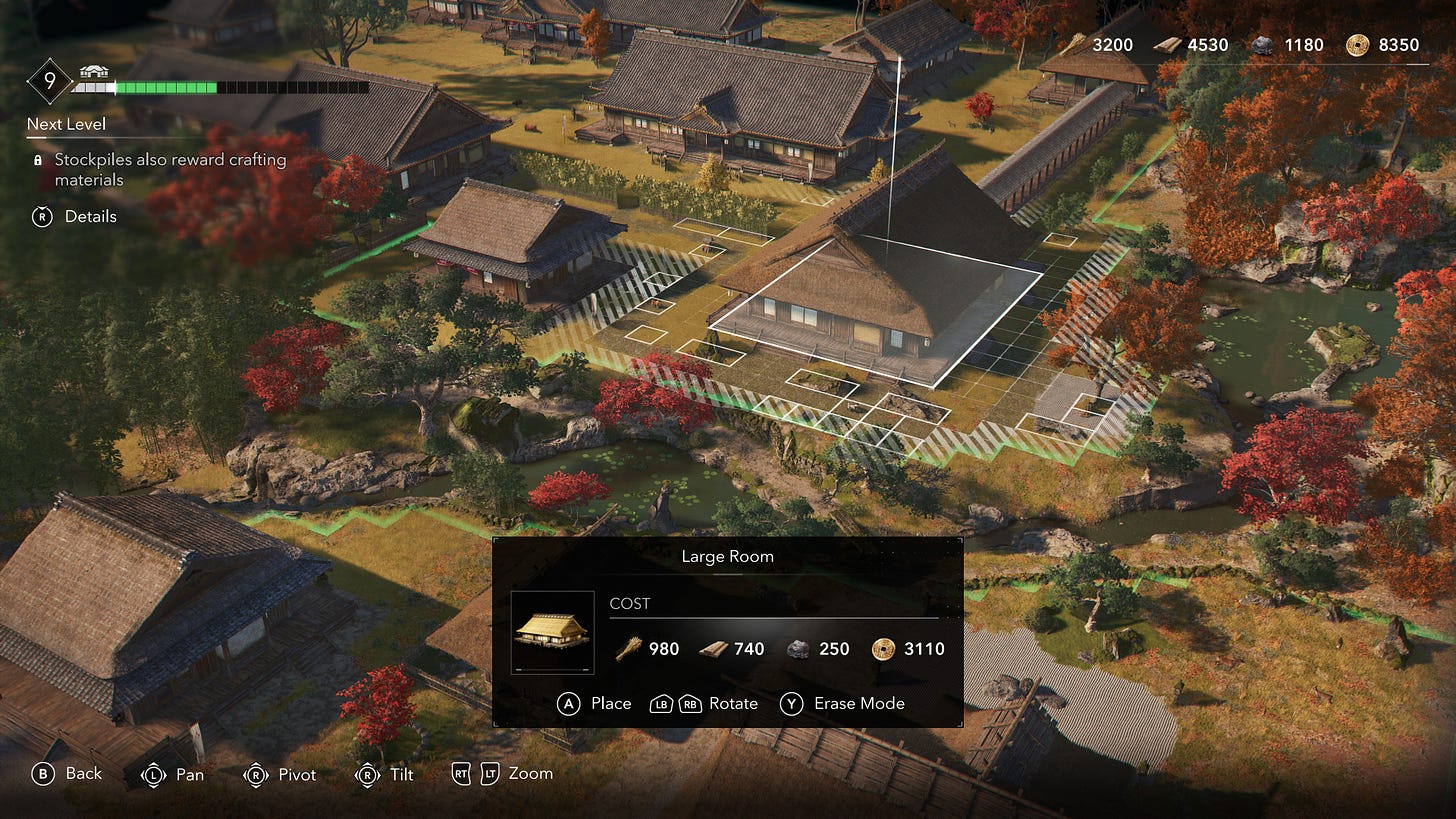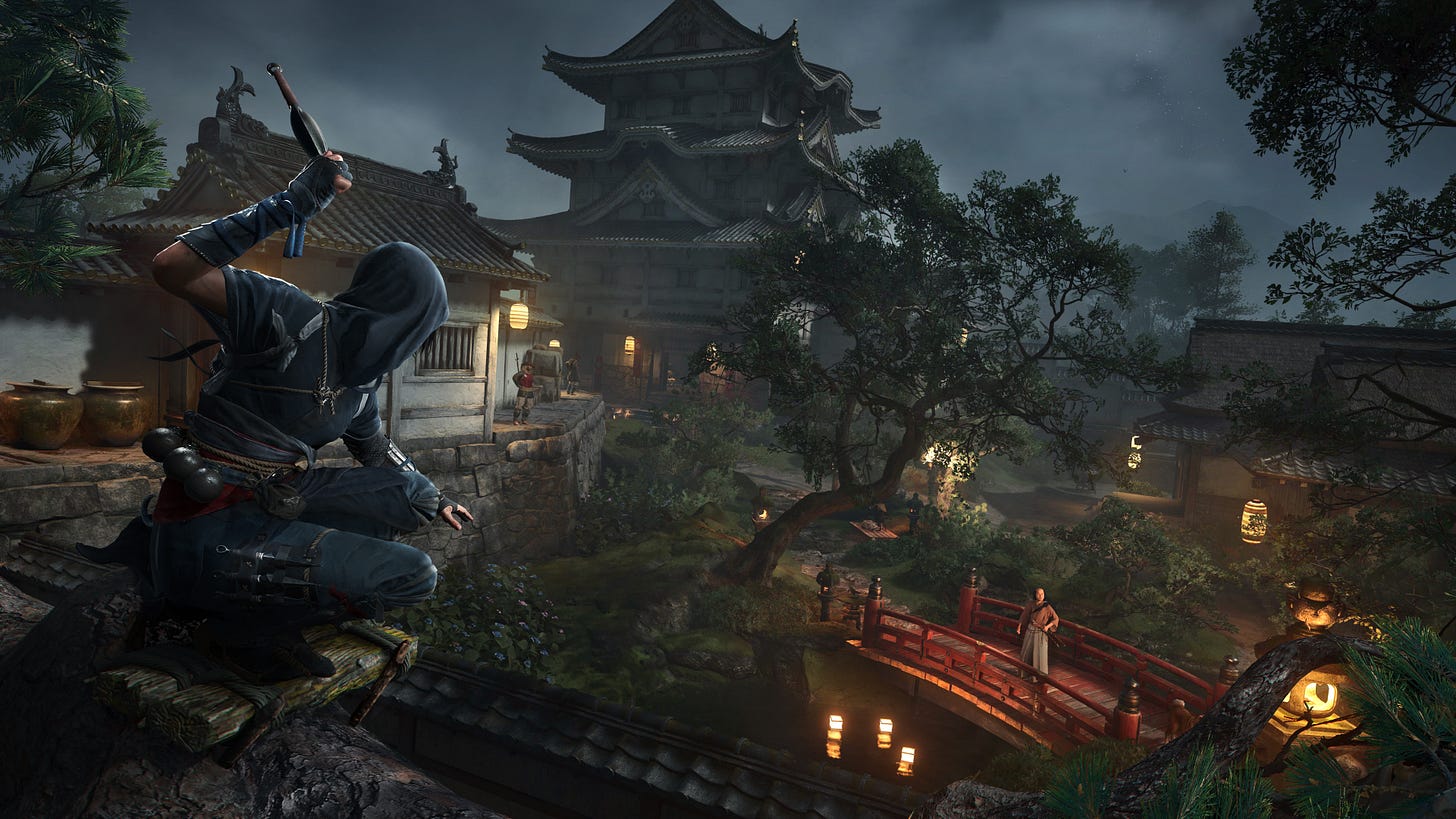Assassin’s Creed has finally arrived in Japan, and the result is something you shouldn’t miss out on.
As a fan of the series I personally felt it was getting a little stale, it never fully captured the originals brilliance. However when they stumble across new features that really shine (looking at you Black Flag), they never carried across those to new entries, which is a shame.
This is why I came into this with a little bit of contention, but I am sure I can’t be the only one who thought an AC game in Japan would absolutely ROCK. So made sure to give it an open hearted honest run.
The delays were worth the wait—Ubisoft Montreal has delivered an epic tale that sets a great precedent for future entries.
Dual Protagonists: Naoe and Yasuke
As you step into the roles of Yasuke the Samurai and Naoe the Shinobi, you’ll fight for the people, challenge tyrants, and shape the future of Japan.
Assassin’s Creed Shadows introduces dual protagonists, offering players the freedom to switch between two distinct playstyles for much of the game.
In the early hours, the story dictates when you play as Yasuke or Naoe, but as the narrative progresses, you gain the flexibility to choose who to control outside of key story missions.
You do spend a MAJORITY of the first 10+ hours as Naoe, which I’ll be honest, I was kinda disappointed at. Not that she isn’t fun to play as, but being FORCED to spend that amount of time felt a little unfair.
Naoe: A shinobi from the Iga region, Naoe embodies the classic Assassin’s Creed experience. Her gameplay is centered on parkour, stealth, and precise assassinations.
Standing at just five feet tall, she’s the most agile protagonist in the series, capable of jaw-dropping acrobatics that feel both fluid and empowering.
Her stealth mechanics are top-notch, allowing you to slip through shadows, scale walls with ease, and perform Olympic-level dismounts from great heights.Yasuke: Known as “The Giant,” Yasuke towers over most characters at six feet tall. His gameplay is a stark contrast to Naoe’s, focusing on brute force and direct combat.
As a samurai, Yasuke can’t rely on stealth like Naoe; instead, he charges into battle, wielding heavy weapons and wearing formidable armor. His size and strength make him a powerhouse in combat, capable of taking on multiple enemies at once.
While he can climb to some extent, his lack of a grappling hook means Naoe is far better suited for reaching high vantage points. Yasuke’s leaps of faith are a must-see—his sheer weight and armor make for a hilariously dramatic descent.
Both characters shine in their own ways, and the ability to switch between them keeps the gameplay fresh and engaging. I just wish we had that ability a little earlier on to mess with.
Feudal Japan: A Living, Breathing World
The true beauty of Assassin’s Creed Shadows is its breathtaking recreation of Feudal Japan. The game’s world is a technical marvel, brought to life by significant upgrades to the Anvil engine. From the wind rustling through leaves to the rain cascading off rooftops, every detail feels real and immersive.
It’s gorgeous to watch as blossoms blow across the dirt paths as the Sun sets over the distance hills.
Seasons and Weather: Japan’s diverse climate is on full display, with distinct seasons that affect both the visuals and gameplay. Spring brings vibrant cherry blossoms, while winter blankets the land in snow, altering how you approach stealth and combat. The dynamic weather system adds another layer of realism—rain can obscure vision, and wind can affect arrow trajectories.
Plus who doesn’t love running through the snow and seeing the cool trails that are left behind.Regions and Historical Accuracy: The game spans multiple regions of mainland Japan, each with its own unique architecture, culture, and challenges. Ubisoft Montreal has woven real historical events and figures into the narrative, grounding the story in authenticity while still allowing for creative freedom. Whether you’re exploring bustling cities or tranquil countryside, the attention to detail is staggering.
Technical Brilliance: The lighting is particularly noteworthy. Morning sun filtering through trees, casting realistic shadows on various surfaces, creates moments of pure visual poetry. The game’s facial animations are another highlight, with characters’ expressions feeling lifelike and emotionally resonant. Cutscenes shift to 30fps to maximise texture and animation quality, making key story moments even more impactful.
I played Shadows on Xbox Series X and was consistently impressed by the beauty of the world and it’s inhabitants.
On Xbox Series X, the Quality (30fps) and Balanced (40fps) modes are stunning, while the Performance (60fps) mode still looks great despite minor lighting downgrades.
I’m personally someone who thinks ALL games should be played at 60fps, the level of smoothness and reactivity just feels right.
That is where I spent all of my time on Shadows and I have to say it really brought that fluidity to both Naoe and Yasuke during fights, while still looking gorgeous.
Gameplay: Stealth, Combat, and Skills
Assassin’s Creed Shadows refines the series’ core mechanics while introducing new systems that enhance both stealth and combat. The two protagonists allow for distinct gameplay experiences, each with their own strengths.
Naoe’s Shinobi Style
Naoe’s gameplay is a love letter to fans of traditional Assassin’s Creed. Her focus is on stealth, parkour, and precision.
Combat and Stealth: Naoe’s combat revolves around parrying white and blue attacks and dodging red ones.
She can assassinate enemies with her hidden blade, instantly killing them if her assassination strength exceeds their health segments.
Her agility allows for seamless transitions between sneaking and striking which is absolutely familiar to all AC fans.Weapons and Tools:
Melee: Katana, Tanto, Kusarigama
Ranged: Kunai, Shuriken, Bell, Smoke Bomb
The Tanto is particularly useful for dual assassinations, while the Kusarigama excels against groups (even being rather overpowered in my opinion).
Kunai are deadly for one tap headshots, and smoke bombs create opportunities for quick escapes or assassinations.
Skill Tree: Naoe’s six skill trees (Katana, Tanto, Kusarigama, Tools, Assassin, Shinobi) offer dozens of nodes with active and passive abilities. You can refund skills at any time, encouraging experimentation. That trumps the pet peeve of mine, where you are permanently stuck into a tree you just wanted to test out.
Naoe’s gameplay is fast, fluid, and rewarding for players who enjoy planning their moves carefully.
Yasuke’s Samurai Might
Yasuke’s gameplay is all about raw power and direct confrontation.
Combat: Yasuke’s brute force makes him a tank in battle. His assassinations are loud and brutal—think decapitations and limb-severing strikes.
The assassinations are not quiet like Naoe and will 100% draw attention of other nearby guards.
He can take more damage than Naoe, but his size makes stealth difficult. His combat style is perfect for players who prefer to face enemies head-on.Weapons:
Melee: Long Katana, Kanabo, Naginata
Ranged: Long Bow, Teppo (one-shot rifle)
The Kanabo, a massive club, is a standout, turning enemies into ragdolls with each swing.
Skill Tree: Yasuke’s six skill trees (Long Katana, Kanabo, Naginata, Long Bow, Teppo, Samurai) focus on enhancing his combat prowess and survivability.
Yasuke’s gameplay is visceral and satisfying, especially when you’re in the mood to wreak havoc. As soon as I unlocked him to play in free roam, I spent the next 20 hours playing him only.
The primary reason? THAT DAMN KICK! The kick is SO satisfying.
Finding ways to kick enemies through walls, off cliffs, off boats, into rivers, so much fun.
All of his attacks also just feel so good, they have a real oomph that you never feel with Naoe.
Both characters share a skill tree system with dozens of nodes, allowing for deep customisation. You can equip two weapons and two active abilities at a time, and skills can be respecced freely.
To unlock new skill levels, you’ll need to complete various activities scattered across the map, such as meditation sessions for Naoe or horseback archery for Yasuke.
That is honestly one of the downfalls of the gameplay in my opinion, none of those activities are fun, they just feel like a grind.
The meditation part especially for me just felt forced, it provided nothing to the gameplay and just hindered the energy of the gameplay loop.
There are also a few buggy things that cropped up throughout the game, such as movement not doing what you wanted, or getting stuck on objects, especially on the horse.
It would also have been nice if we could auto-travel while on the horse, we can already turn on a glorified sat-nav, so why not let us hold a button to auto-walk like we can in the story missions.
Overall, extremely fun and rewarding gameplay that provided me many moments of joy.
The Quest Board: A World Full of Stories
Assassin’s Creed Shadows introduces a new quest board system that organises the game’s vast content into manageable chunks. As you progress, the board fills with circular zones and faction-specific quests, giving you a clear sense of what’s available.
It also really feels nice when you find a new region of the board unlock and a plethora of new enemies to assassinate open up.
Quest Variety: The quests range from main story missions to side activities like rescuing allies or looting strongholds. Each region and sub-region unlocks new quests, ensuring there’s always something to do. The map is enormous, covering a significant portion of mainland Japan, and fast travel points make navigation easy. They unlock some unique equipment which is nice for loot goblins like me.
Pacing and Freedom: Unlike some past entries, Shadows never forces you into side content. If you focus solely on the critical path, you can finish in about 30-35 hours, but the side quests are so well-crafted that you’ll want to dive in or just get lost in the open world like I do. Found myself taking over a higher level castle for an hour when I really shouldn’t of been trying, but I liked the challenge.
The quest board keeps everything organised, and with so much to do, it’s easy to lose yourself in the world for 80+ hours.
Story: A Tale of Revenge and Redemption
Without delving into spoilers, Assassin’s Creed Shadows tells a gripping story of revenge, redemption, and the fight against tyranny. The game offers two story modes: “Choose Your Own Adventure” and “Canon Mode.” I opted for Canon Mode, which provides a fixed narrative path, but the choice-driven mode offers significant replayability with different outcomes based on your decisions.
Naoe’s Journey: Naoe begins as a young shinobi seeking answers about her mother’s death and her father’s mysterious past. Her story is one of self-discovery, as she uncovers her family’s ties to the Assassins and learns to wield her hidden blade.
Yasuke’s Path: Yasuke, a former slave turned samurai, fights to protect Japan from foreign influence. His story is one of honour and redemption, as he grapples with his past while forging a new identity. The game doesn’t shy away from his brutal history, and his journey is both inspiring and heartbreaking.
Themes and Choices: The narrative explores themes of forgiveness, loyalty, and sacrifice. Even in Canon Mode, the story feels personal and impactful, with Naoe and Yasuke’s friendship serving as a emotional anchor.
The story is rather well paced although perhaps a little slow, and while the Assassin vs. Templar conflict takes a backseat, it’s still present and brilliantly executed when it comes to the forefront. The ending leaves room for future adventures, and I’m already eager for more.
Home Base: Build, Decorate, and Thrive
Early in Naoe’s story, you’ll unlock the hideout—a customisable home base that serves as both a hub and a homestead builder. Here, you can place buildings, decorations, and even pets that you collect in the open world, creating a space that reflects your style.
Buildings and Benefits: Each building offers passive bonuses, such as extra scouts who help you locate objectives or gather resources. You’ll need materials from looting strongholds to construct new buildings, adding a strategic layer to exploration as long as you can keep enough scouts around (I struggled!).
Allies and Upgrades: Allies you recruit can be trained at the dojo, making them more effective in combat. One of my favourite allies, Yaya, is a towering woman who choke-slams enemies with brutal efficiency. She really helped me when taking out some castles and elite enemies, as she just knocks them out and I can go in to finish them.
Customisation: With hundreds of items to collect, from furniture to garden decorations, the hideout is a decorator’s dream. You can also unlock scout hubs in cities, which serve as fast travel points and resource collection spots.
The hideout adds a personal touch to the game, and I’m sure you can spend hours perfecting your own Assassin space. I’ve seen some rather radical creations online, feel free to go take a look.
A New Era: The Animus Hub and Microtransactions
Assassin’s Creed Shadows introduces the Animus Hub, a new launcher that consolidates recent AC titles (from Origins onward).
I have to say it feels a little strange opening the game up to be introduced to a launcher where you select the game, even after you have opened it on console.
Maybe it will feel more natural as we progress down the line.
Microtransactions: The game includes a microtransaction store with level-appropriate gear and cosmetic items. Some of which I have to say, have AWESOME looking visuals, I wish you could get them via gameplay though.
There are also free reward tracks (basically battle passes) that you can progress through by completing daily and weekly quests.
While some may find this off-putting, I earned enough in-game currency to buy a couple items without spending real money.
Feudal Funk: Vibes and Atmosphere
Assassin’s Creed Shadows nails the atmosphere of Feudal Japan.
The game’s soundtrack blends classical tunes with traditional instruments, as well as some rather ‘Tarantino-esque’ sounding funky tunes. I have to say, the music in some places did really detract or at least distract from the cutscenes in some places when they used those upbeat almost hip-hop sounding tunes.
The canon voice mode, which features Japanese and Portuguese dialogue, adds to the immersion (though English voice acting is also available, but I’d say a little ‘average’).
Overall AC Shadows has a vibe that just feels 'chill’.
Whether I am slow motion walking around as Yasuke feeling badass, or hopping across tree branches as Naoe while casing the next Castle, it always feels slick.
The beautiful visuals of the world, the weather effects, the whistling of the wind as it rustles through the bamboo, it just captures what an average gamer like me, imagines Japan to feel like.
Conclusion: The Best Action-based Assassin’s Creed Yet
Assassin’s Creed Shadows is a triumph.
To me, it’s the most fun I’ve had in a recent entry of the series, excelling in every area—from its Samurai gameplay to its breathtaking world and above average story.
While things like the microtransaction system, occasional buggy AI, slightly clunky movement, do exist, they are a minor blemish on an otherwise gorgeous gaming experience.
Disregard other peoples opinions, the silly controversy and hate that gets blabbed about online. Grab the game and have yourself one of the best Samurai experiences to ever exist.
Shadows is a must-play for fans of the series and newcomers alike.

